Round of 16: Brazil 2-0 Mexico
In the heat of Samara, Brazil comfortably advanced to the quarterfinals as Mexico ran out of steam.
Brazil fielded their expected starting selection in a 4-3-3, with Filipe Luis replacing Marcelo’s place in the team due to back spasms. Mexico tweaked their team, in part due to the suspension of Hector Moreno. Hugo Ayala functioned as the right centre back as Salcedo moved to the left. Rafa Marquez started the match as the holding midfielder, with Herrera and Guardado in front of him as the 8’s, leaving Miguel Layun out of the team. Moving back to a 4-3-3, Juan Carlos Osorio also opted to swap the sides of the wingers, with Vela and Lozano starting on the left and right respectively.
Mexico Start Brightly
The opening phases of the match saw Mexico attempt to play a proactive approach to defending Brazil. Rather than implement a low block that Brazil encountered against Costa Rica (which Mexico used in their win against Germany), Mexico used a high press to prevent Brazil from being able to impose their tempo and control on the match.
Mexico were heavily man-oriented in their coverage, pressing high up with each of the wingers on the fullbacks and Hernandez pressing the closer of the two centre backs in relation to the ball. These man orientations were difficult for Brazil to beat at first for multiple reasons. Early on, Mexico were able to apply their pressure with high intensity, reacting and step to the ball as the ball was being circulated from one player to the other. With the midfielders marked tightly, Brazil chose to possess among the defensive line, who were conservative in their positioning throughout the match.
This included Brazil’s fullbacks, who each ventured forward at a lower frequency than in other matches. Given the Mexican strength on the counter attack, the request for Fagner and Filipe Luis to limit their attacking was logical. Against Germany, Mexico could have managed to score two or three goals at least if they executed final actions better on the break. Implementing a similar focus on counter attacking, the play of Vela and Lozano would be pivotal to getting a result.
This behavior from the fullbacks had early consequences for Brazil’s possession, aiding Mexico’s pressing scheme. The man-orientations of Mexico successfully prevented Brazil’s wide players from receiving passes because of their tight coverage when on the ball side. As Neymar and Willian looked to extend the game vertically, the remainder of A Selecao consolidated their possession.
With the wingers resigned to staying near the touchlines in higher spots, their primary way of getting a share of the ball was to move into a lower line of possession and drop deeper. Gradually, Brazil’s defenders began to carry the ball forward more as they found ways to bypass Javier Hernandez in Mexico’s initial pressure. Rather than play directly into the central players who were marked man for man, they played wide. This turned out worse for the Brazilians however, since Mexico’s wingers occupied positions in which they had access to both the wingers and fullbacks for pressing. Once the ball was played into the wings, Vela or Lozano would backpress the player on their respective side to double the pressure surrounding the ball. As skillful as Brazil’s dribblers are, they were unable to escape these situations.
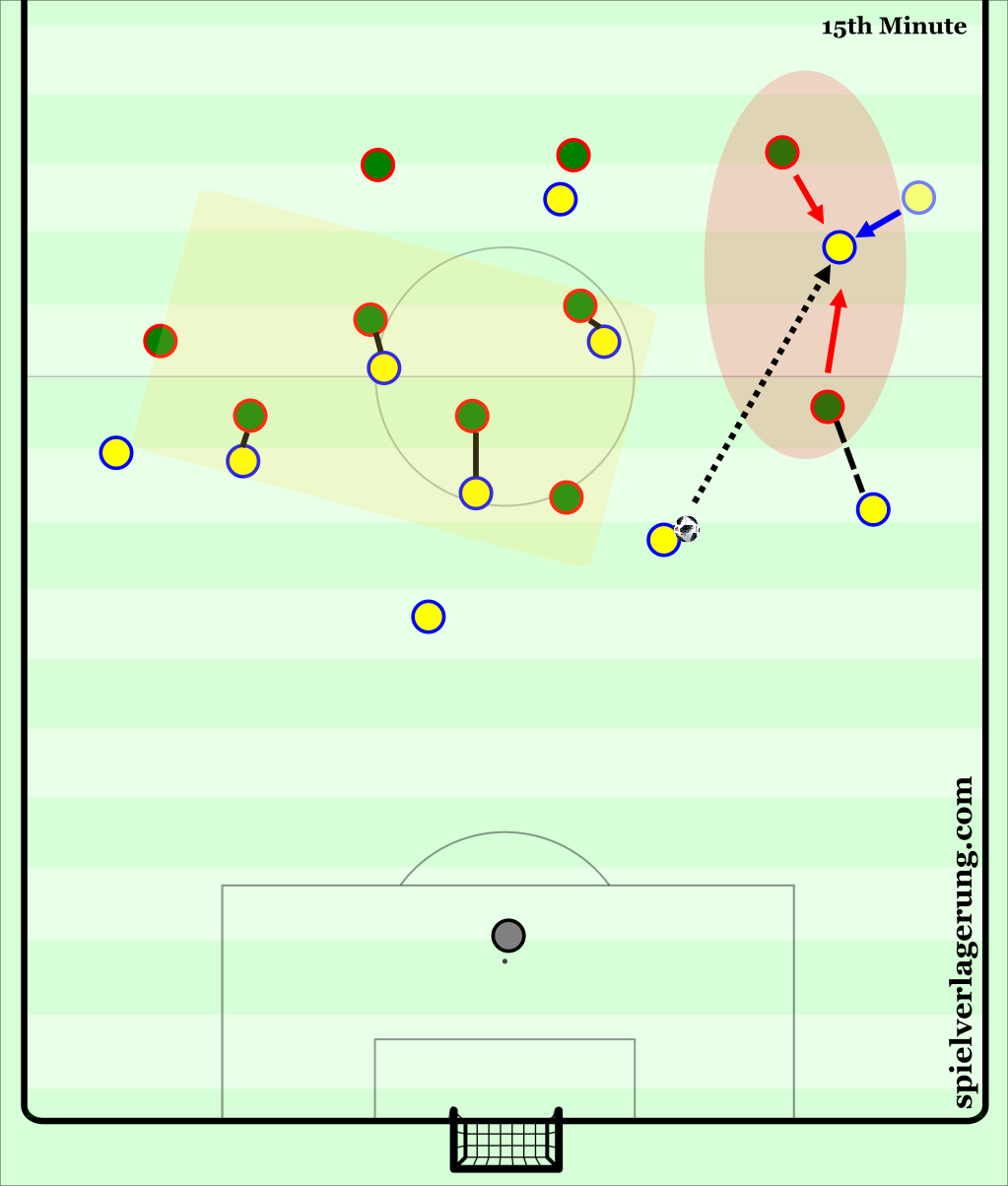
Mexico’s man oriented press. Mexican wingers left their player as the ball is played into Brazil’s wide men in order to pressure 2v1 on the flanks.
Mexico created some attacks with promise originating from this circumstance. Yet different issues arose on their transition play than in the Germany match. Rather than have execution errors accompanied by correct decisions, Mexico’s attackers oftentimes made the incorrect choices. It was a common sight to see Mexican attackers prefer to take shots from distance when running toward goal rather than pass to a teammate who was in a preferable position. Players frequently dribbled excessively, delaying their passes or shots marginally leading to enough reaction time from Brazil to extinguish the threats.
Despite these mistakes, Mexico’s start was still pretty promising from a possession point of view. Brazil had initially stepped up their lines as well to prevent their opponents from building through their centre backs and midfield. Yet Guillermo Ochoa was quite good in his distribution from both his feet and hands, finding the free player to bypass this high pressure and have Brazil retreat into their conventional midfield press.
Once Brazil was set up in their prototypical structure, El Tri effectively managed the tempo through their patience on the ball, with much of their circulation being from side to side, as Brazil covered the options in front and sparingly applied pressure to the defensive line. Over time, the Mexican side would’ve hoped that Brazil would eventually peter out, creating more spaces for Mexico to attack during their possession and make their counter attacks more dangerous. However, this plan backfired, as Mexico suffered the fate of fatigue that they wished to implement on their opponents.
Brazil Gain Control…
Mexico had struggles progressing their attacks through conventional means, as Brazil’s midfield pressure was quite good with respect to reacting to central passes and preventing further passes from being played forward with their cover shadow. Due to this lack of progression in their attacks, Mexico’s possession spells comprised of counter attacks that varied in length, or predominately circulation among the defensive line in search for openings. Yet these possession spells became shorter and shorter as the half wore on, in the process stretching the distances between attack and defense in transitional moments. Brazil now had ample room to impose their style of play on this match.
When the opponents were progressed up the field, any ball recoveries that Brazil had in their defensive third were effectively circulated. With Mexico’s man-orientations, the usage of Alisson in build up disturbs the Mexican scheme: drop off and Alisson has time to pick out a pass to progress play; or apply pressure at the risk of being opened up in midfield and have the Brazilians easier march on. The Roma goalkeeper was fantastic in his range and accuracy of passing, contributing to quality moments of build up play throughout the first half.
The exemplary goalkeeper build up play was just one way that Mexico’s reactivity from their man-orientations drove them into the ground. Coutinho’s active movement tormented Rafael Marquez, a tall order for the 39 year old to prevent him from influencing the match too much. The premature counter attack endings, man-orientations, and Brazil’s expansive ball movement sent Mexico all over the pitch. The buzz that Mexico had in the early moments of the match had evaporated in the heat, with the temperature of 32 degrees likely contributing to early onset moments of fatigue around 30 minutes into the match.
The last period of the first half was spent mostly in the Mexican half, aiming to keep with the flair of Brazil’s players alongside the penetrative intricacy of their team play in the final third. Mexico moved to a deeper block for these spells. With their wingers still higher up in the pitch in anticipation of their transition play, the total area that Mexico’s midfield three had to cover was quite large. Factor in the speed of play that Brazil passed the ball from one player to the next, and it is difficult to imagine how Mexico could keep up the intensity found in the earlier minutes, especially considering most of these players had already played three matches in the last two week.
The dribbling of Willian and Neymar become a bit too much for Mexico to contain and they eventually resorted to fouling as a means of both denying their clearance to goal and a means of getting reorganized as the referee stoppages gave Mexico marginal seconds to catch their breath and get back into their starting positions. Mexican transition play was rapidly snuffed out by the electric counterpressure of Brazil, getting multiple players pressing the ball instantly after losing it, thus coercing their opponents into ceding possession.
With the intensity of Brazil’s attacking soaring up as Mexico’s intensity wound down, Brazil put together passages of play reminiscent of the samba football that the world has come to know over the years. Gabriel Jesus’ movement individually was crucial in occupying the centre backs as Coutinho moved into higher spaces, or when Willian ventured toward the middle. As Neymar began to run at Brazil more and more, Filipe Luis joined him, adding more chaos for Mexico to deal with. Brazil broke through their opponents through diagonal passes into these halfspaces as wingers moved inside, followed by dribbles to create shots or passes for teammates. Guillermo Ochoa could only stand on his head for so long, but was titanic for his team in keeping Brazil scoreless until halftime.
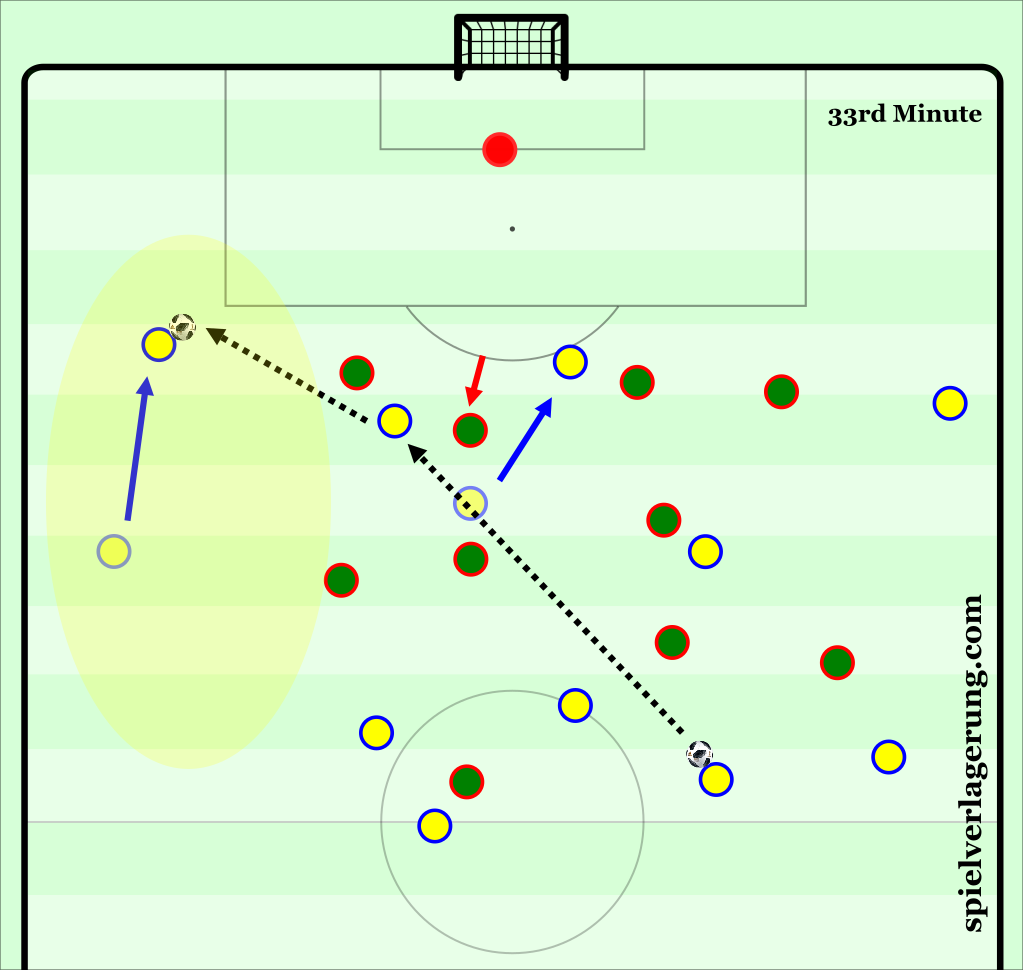
One instance of a strong Brazilian attack, where Silva plays into Jesus’ feet, cleverly dummied by Paulinho. This sequence ends in a save by Ochoa from a Jesus shot.
Interesting aside: An area of note where Mexico wanted to quell Brazil during their spell of dominance was on corner kicks. Throughout the tournament, they have left up their front three to bolster their counterattacking, being the first priority once they clear the ball or when Ochoa catches any services. Brazil were mindful of this tendency, not sending Thiago Silva into the penalty area to get his head onto any deliveries from standards, alongside man marking the front three to ensure numerical superiority to deal with any counters. Brazil thus only sent four or five players for corner kick movements, lending an eye to how Mexico would attempt to snatch a goal away from them.
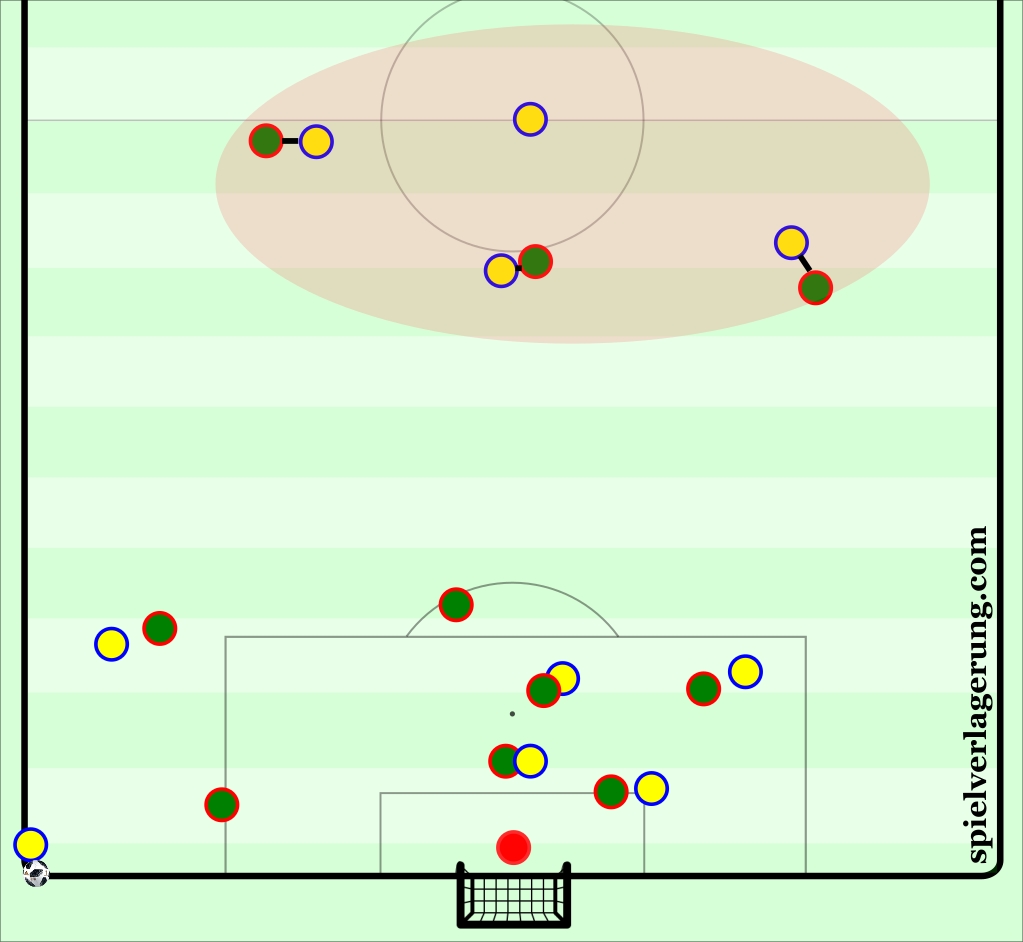
Brazil’s defensive setup of attacking corner kicks – with Thiago Silva acting as the free player in the 4v3.
… And Pull Away
Osorio made his first change at halftime, introducing Miguel Layun for the lagging Marquez. Edson Alvarez was moved to holding midfield, thus putting Layun at his typical position of fullback. Aside from that, little changed about the approach either team took to the game and the overall pattern of play. Neymar gave his side the lead five minutes into the second half via a scintillating team goal from start to finish, where after a quick recharge, Mexico’s signs of fatigue were evident as Casemiro had plenty of room in front of him to play the switching ball that initiated the attack.
Additional shifts were made in the form of Jonathan dos Santos and Raul Jimenez, as Mexico exerted themselves with their counterattacks and movements in behind, resulting in some chances that hardly troubled Alisson. Many other Mexican penetration efforts were expertly anticipated by Thiago Silva and when in individuals duels, none of the Mexican contingent could pass through Miranda. As Jimenez entered the match, the focus of attack became more aerial in line with his player strengths.
Mexico began to muster longer spells possession shortly after, partially because Brazil dropped off their pressure to bolster their defense in front of their goal as Jimenez became targeted more and more. This compactness prompted Mexican midfielders to drop out of tight spaces in the halfspaces, causing many players to position themselves in front of the ball and not much occupation of higher lines. Lozano, who by this point had switched with Vela to play on the left now, seemed to be the only one looking to attack through means besides crossing. Osorio’s team became void of ideas, out of solutions of how to get by this impermeable Brazilian group.
Shortly before minute 90, Roberto Firmino, who had replaced Jesus earlier on, tapped in Neymar’s effort generated from a Paulinho interception to secure their place in the quarterfinals. While Mexico may have had a fair share of the ball in the second half, Brazil attacked with much more speed and intensity to emphasize their quality.
Conclusion
Brazil advance to the quarterfinals in a deserving two goal win, now having to face Belgium in a match that could be logically tipped as a final if it were another occasion. Their mixture of attacking ingenuity, stability, and individual defensive quality in their team makes them the favorite for winning the tournament. Indivdually, Willian was very impressive in this match, and Brazil’s front three will torment any opposition they encounter, while Tite has found a nice balance in midfield to the tune of Coutinho, Paulinho, and Casemiro.
Mexico bow out, likely marking the end of Juan Carlos Osorio’s time in charge of El Tri. He was unable to get to the elusive fifth game, and also did not muster a victory in the knockout rounds of any FIFA tournament with exception to the Gold Cup. However, the gulf in quality between these two teams was always a difficult task to overcome, as not one Mexican player could start on this Brazil team on a good day. It is hard to imagine Osorio having taken this group of players to a performance level higher than he did, and the match against Sweden will haunt him and the team considering they failed to capitalize on a fantastic opportunity to reach the quarterfinals. They leave having shown a flexibility to their play that few other teams were able to successfully implement throughout the tournament. With passions high, perhaps expectations soar as well, even if there isn’t always the foundation behind it.
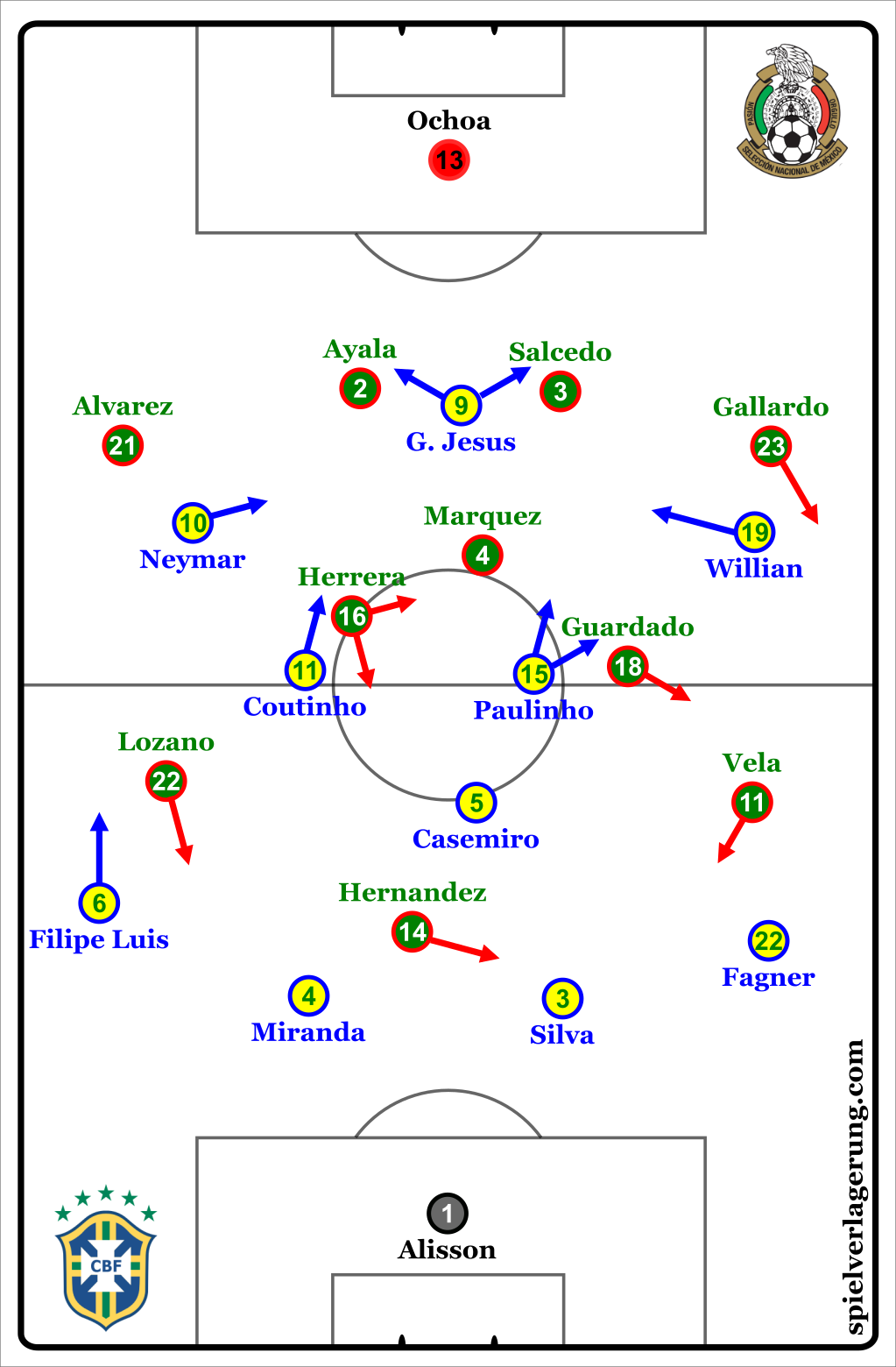
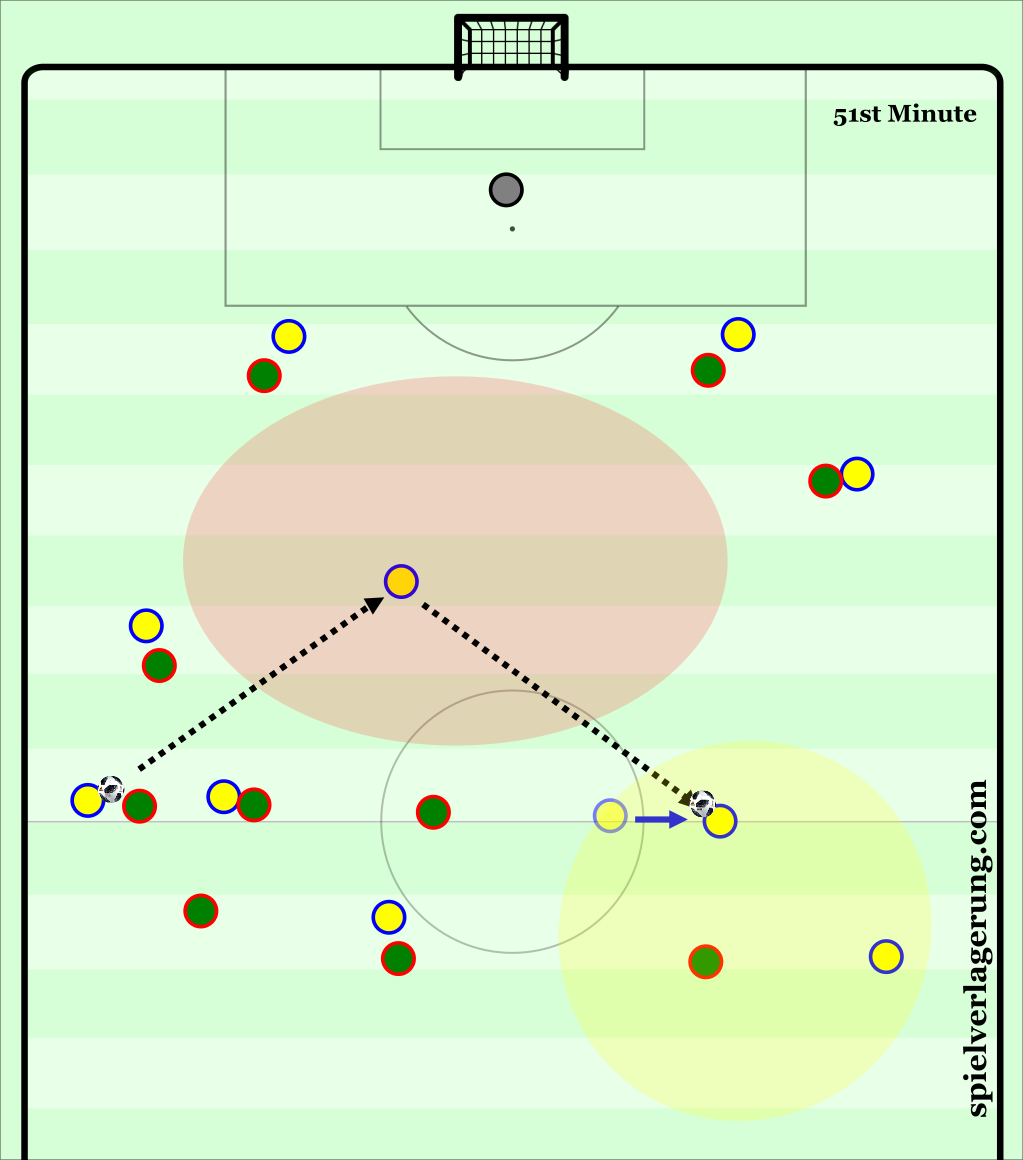
Keine Kommentare vorhanden Alle anzeigen